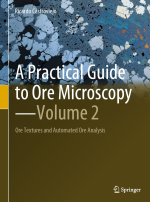Добрый день, Коллеги. Важное сообщение, просьба принять участие. Музей Ферсмана ищет помощь для реставрационных работ в помещении. Подробности по ссылке
A practical guide to ore microscopy. Volume 2. Ore textures and automated ore analysis / Практическое руководство по рудной микроскопии (минераграфия). Часть 2. Рудные текстуры и автоматический рудный анализ
In nature, minerals are usually found in association, forming rocks. Ores are no exception: they are almost always composed of different species, forming intergrowths. The study, description and interpretation of these intergrowths is the objective of textural analysis and is very important for mineralogy, both from a scientific point of view (e.g. mineral genesis) and for a practical approach (e.g. mining exploration and minerallurgy).
Mineral processing or minerallurgy (ore processing) involves processing the mineral in industrial plants for its benefit, aiming at the most efficient procedure to sort the useful components (ore) from the tailings to be discarded (gangue). Efficiency also means environmental responsibility or sustainability, implying the capacity to predict the impact, and then to tightly control operations and waste. For this, the mineralogical and textural characterization of the ore provides indispensable information, not only to optimise plant processes (grinding, gravimetry, flotation, etc.) but in earlier phases of the deposit’s exploration and evaluation to provide an orientation for the investor. This is due to its potential to predict the behaviour of the mineral in the plant and its appropriate treatment (predictive mineralogy). This information is of transcendental importance to defining the viability of the project. These data are also linked to good practices required for quality standards (cf. § 1.1, vol. 1).
This information will be briefly discussed below (cf. § 1.2.3) in relation to geometallurgical applications, but first it is necessary to ensure the correct description and understanding of the textures in their fundamental features (§ 1.1). For this purpose, we first try to find the most suitable criteria to establish a clear and useful classification of the most common ore textures. This should lead to a logical identification scheme, avoiding oversimplification or ambiguity, as well as superfluous intricacies. Next, in applying these criteria, these textures are defined and analysed from the points of view of the mineral deposit researcher, the exploration geologist, the plant engineer or scholar of metallic ores. For this purpose, the scheme of Box 1 will be followed, to summarize in an accessible way the complex universe of the textures of metallic ores, grouping them by three criteria: I Descriptive, either referring to individual grains (Table 1.1) or to aggregates (Table 1.2); II Genetic (Table 1.3); III Geometallurgical (Table 1.4). These tables will be completed when discussed.




